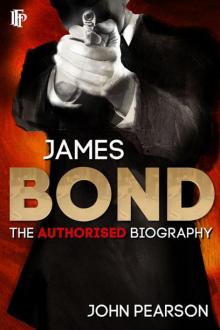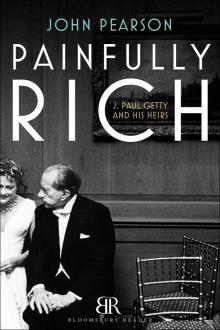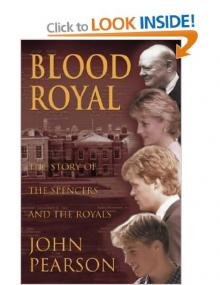- Home
- John Pearson
Blood Royal: The Story of the Spencers and the Royals Page 2
Blood Royal: The Story of the Spencers and the Royals Read online
Page 2
Long before he built his tomb he had achieved this with his son and heir, young William Spencer, when he married him to Susan Knightley, daughter of one of the richest families in Northamptonshire. When it was Susan and William’s turn to find their son a wife they were more ambitious still, moving outside the county to tap into the wealth of the City of London by marrying John Spencer II to Katherine Kitson, daughter of the ‘merchant prince of London’, Sir Thomas Kitson. Sir John Spencer II was the first member of the family to become a local MP, and he and his wife had ten surviving children, six of whom were daughters. But they were rich enough to provide sufficient dowries to marry all the girls but one into the landed aristocracy. One daughter, Anne, was widowed twice, becoming successively Lady Mounteagle, then Lady Compton and ending up as the Countess of Dorset. Her sister, Alice, became Countess of Derby.
However, when John and Katherine came to choose a wife for their son and heir, John Spencer III, they avoided both the aristocracy and the City, and picked on an area of conspicuous wealth – that of the flourishing rich Tudor lawyers. John was married to the great heiress Mary Caitlin, daughter of Chief Justice Sir Robert Caitlin, and when she died the bulk of the great Bedfordshire estates of the Caitlins descended to her son Robert, thus enriching further still the fortunate and fertile breed of Spencers.
Throughout the reign of Elizabeth I the Spencers continued to advance, for these were serious people following their life’s essential purpose. They had found no problem in embracing the new religion after the Reformation and the Protestant work ethic clearly suited them. Since they had succeeded, God was clearly with them and, despite their wealth, they dressed soberly, lived righteously and continued to invest extremely shrewdly. They never borrowed. Surplus capital was spent on further purchases of land, and the family domain grew accordingly.
They were not miserly so much as careful, even in their hospitality, and although Althorp was considerably enlarged in 1577 with Caitlin money, it was widely said that ‘the Spencers always tempered ostentation with frugality’. But just as their wealth protected them, so it also formed the basis of their social standing and they were being counted among the top-most ranks of the gentry of Northamptonshire.
But their ambitions were no longer exclusively confined within their county; having intermarried with so many grander families, the Spencers were almost ready for the most important move of all – upwards into the aristocracy.
In normal circumstances a farming family, however prosperous, but lacking noble ancestry or court connections, would have found this difficult, particularly with the barriers of class and breeding and an ageing Queen Elizabeth increasingly reluctant to dilute her aristocracy with fresh creations. But the Spencers always had what Napoleon demanded of his marshals – luck. And few were luckier than the current heir, Robert Spencer.
After the founding father, Sir John Spencer I, Robert Spencer is the most important figure to emerge so far within the upwardly mobile House of Spencer. He started life with the unusual advantage in this fertile family of being an only child, so that all the resources of the Spencers and the Caitlins funnelled down to him alone. He was to prove remarkably adroit at making the most of them.
While holding to the Spencer virtues - shrewdness over money, discreet ambition and the calm composure of the countryman -Robert appears to have inherited the sharpness and the ready tongue which made the Caitlins such successful lawyers. He had sufficient culture to befriend the playwright Ben Jonson, and saw the necessity in a vulgar age of spending conspicuously to enhance one’s standing.
As only son and heir to a rich inheritance, Robert could count on a settlement to tempt the wealthiest heiress, and when his marriage was arranged with seventeen year-old Margaret, daughter of the notoriously rich Nottinghamshire entrepreneur and landowner, Sir Francis Willoughby, great hopes were set upon the union. Margaret dutifully produced three daughters and three sons in swift succession. Then in 1597 she died in childbirth.
Robert records her passing rather like the cool businessman he was: ‘Margaret, my most loving wife, having borne me all those children. She was one of the daughters and co-heirs of Sir Francis Willoughby, of honourable parentage, but her virtue surpassed all.’
Although only twenty-seven at the time, Robert never remarried. He was probably too busy, and Margaret, after all, had left him with sufficient children. Had he felt the urge to remarry there was a warning close at hand in the fate of his own rich father-in-law. Sir Francis had taken a second wife, and brought disaster on his family. Heavily in debt, and infatuated with his young bride, he had made all his remaining property over to her, then died intestate not long before Margaret herself, leaving her, and hence the Spencers, next to nothing.
It was a rare example of marriage with an heiress back-firing; but, far from repining, Robert was soon making greater efforts to repair the damage, and adding to the fortunes of the Spencers in the process. He received his full inheritance on the death of his father, Sir John Spencer III, in 1599, and almost immediately started to expand the house at Althorp, increasing it in size and splendour. He also turned his attention to the family business, becoming in the process the nearest thing in Tudor England to a modern marketing tycoon.
He remained very much a farmer, and under his direction the two great Spencer farms at Althorp and Wormleighton were developed to their full potential. But his true achievement was to make these farms part of a carefully worked-out large-scale marketing operation. The Spencer sheep had always been renowned for ‘the sweetness and richness of their flesh’, and he now concentrated on the regular production of animals for the London market. Thanks to the scale of his business he could cut out middle-men and, with Althorp relatively close to London, could deal directly with the Smithfield butchers to satisfy the growing city’s apparently insatiable demand for meat. He was a regular supplier to merchants like Messrs Zackery and Cutts, ‘butchers dweling in Est Chepe’, and also to the rich wool stapler Henry Moore of Bishopsgate, who purchased what was called ‘the single clip’, an entire season’s shearing from the Spencer flock.
At the end of the sixteenth century it must have taken an organising genius to cope with more than 12,000 breeding ewes and lambs each season, and oversee the portage of several thousand sheep the seventy-odd miles from Althorp to Eastcheap in a state to produce edible mutton on their arrival. Sir Robert would have used expert drovers, but once the Spencer flocks were on the move the logistics must have been formidable, calling for precise arrangements for their pasturing en route to London.
With much of his business conducted in the capital, Sir Robert, now a rich young widower, had closer contacts there than previous Spencers, and lived part of every year in London. He was in London early in 1603 when Queen Elizabeth was dying, and must have known the time had come to get his title.
He was so keen to make a good impression on Elizabeth’s successor, that he was among the crowd of rich Londoners who rode out specially to welcome James I from Scotland at the gates of London. He followed this a few weeks later with a masque, speedily written by Ben Jonson, which he staged at Althorp in honour of the royal consort, Anne of Denmark, as she journeyed down to London. Thus Anne became the first of many royal guests to stay at Althorp.
Among the many differences between King James and Queen Elizabeth was their attitude to honours, which James regarded rather as Robert Spencer regarded sheep - as an eminently saleable commodity. Anyone with an income of £200 or more was obliged by this hungry king to buy a knighthood. Serious honours cost considerably more and shortly after entertaining Anne of Denmark as his guest, Robert Spencer, like the honest businessman he was, paid James I £3,000, cash down, for a barony.
Now that he had his peerage and was on speaking terms with royalty, it might have seemed as if the new Lord Spencer was about to make another break with family tradition and become a courtier. Since he was rich and handsome, some may have feared the worst when the King, who was notoriously susceptible to you
ng good-looking males, appointed him to head an embassy to the German court of Wurttemberg, to invest its reigning Duke with the Order of the Garter.
This meant crossing France, and as the first of his family venturing abroad the new Lord Spencer was soon exhibiting the true-born Englishman’s suspicion of the French. The nobility of France are poor; the gentry of France are crafty; the vulgar are rude and unconscionable,’ he wrote.
Nor did the splendours of the court of Wurttemberg, which included ‘walking on red cloth spread for the purpose’ at the investiture, particularly impress him. Despite the Duke’s gift of a splendid piece of plate, the only moment when Lord Spencer’s spirits rose was when the Duke announced that he would pay for his expenses.
Having failed to enjoy the court of Wurttemberg, it is hardly surprising that Robert also failed to appreciate the court of King James, which was acquiring a dubious reputation. The King was personally repellent, some of his courtiers were worse, and although the court could be a source of personal enrichment, Robert knew better ways of growing rich. Far from being keen ‘to serve his king and country’, he became one Spencer who henceforth would keep as far away from court and king as possible.
He stuck by this decision for the rest of his life, refusing any further honours. Even the earldom which the King offered him some years later for a mere £10,000, failed to tempt him. Another rising dynasty, the Cavendishes, who were also busily enriching themselves from sheep, did purchase one. But Robert seemed happy with his humble barony, and genuinely preferred the rich green fields of Northamptonshire to the suspect pleasures of Whitehall. He enlarged the original Spencer house at Wormleighton, but seems to have preferred Althorp, where he planted trees and built a gabled ‘stand’ for his favourite pastime - hawking. It was at Althorp that an eighteenth-century historian described the shepherd baron, like some uncorrupted senator from republican Rome, ‘making the countrie a virtuous court where his flocks and fields brought him more calm and happie contentment than the various and mutable dispensations of the court’.
But Robert Spencer was no country bumpkin. By avoiding the court, investing shrewdly, and concentrating on the wholesale meat trade, he amassed a truly fearsome fortune and was widely reputed ‘to have by him the most mony of any person in the kingdom’. Actually there were families with ancestral lands and property who were richer, but Robert Spencer was unusual in that much of his wealth was in ready money and could be called on at a moment’s notice. This was another Spencer characteristic he had inherited together with his calling. Graziers and cattle dealers traditionally carried large amounts of money - to buy and sell and deal in livestock and in land. And like the grazier that he remained, Robert used his cash in hand to improve still further the quality of his livestock and the standing of his family.
Although he had no problems in purchasing his peerage from King James I, the new Lord Spencer seems to have encountered snobbery from certain members of more ancient families. With his quick wit and self-assurance, this was something he could cope with if the famous story of his House of Lords encounter with the ill-mannered Lord Arundel is any indication.
During a speech, Robert was harking back to earlier times, when Lord Arundel rudely interrupted him. ‘When these things were doing, the noble Lord’s ancestors were keeping sheep,’ he shouted.
‘When my ancestors were keeping sheep, the noble Lord’s ancestors were plotting treason,’ Robert answered.
Uproar ensued, and Arundel was briefly committed to the Tower for contempt of Parliament, before apologising.
But although quick-witted Robert got the better of the graceless Arundel, whose father and grandfather had both met their fate on Tower Hill, the shaft seems to have gone home. Robert’s father, Sir John Spencer III, had in fact already done his best to offset any stigma attached to the parvenu status of the Spencers by hiring an official from the College of Heralds to trace their genealogy.
He must have paid him well for, after lengthy study, the herald produced an elaborate family tree linking the Spencers with a far older family whose name was conveniently similar to theirs - the Despensers of Gloucestershire. Although by then extinct, the Despensers had come to England with the Conqueror, and had been extremely powerful in the Middle Ages.
With this descent established, the College of Heralds permitted the Spencers to bear the Despenser arms - which they duly did, and despite the sneers of people like the Arundels, would soon take their place among the ranks of the most ancient families in the land for virtually the next three centuries. Not until 1901 would the famous genealogist, Professor J.H. Round, examine the Spencer pedigree in detail and expose it as an almost total fabrication; apart from the similarity of name there was clearly no real connection between the Althorp Spencers and the ancient race of the Despensers.
But the Professor’s revelations came too late to worry the Spencers in the least. By then the aristocracy was being swamped with the new creations of Victorian England - plutocratic dukes, banking earls, industrial barons - making the Spencers seem positively feudal in comparison. In their own right they had grown genealogically old, and if they had missed the Norman Conquest no one noticed.
But in Stuart England lineage mattered, and once the Spencers had established their right to bear the Despenser arms there was little to prevent them rising to the topmost reaches of the aristocracy. In 1614 Robert linked the Spencers with another, considerably grander, family by marrying his son and heir, William Spencer, to Penelope Wriothesley, daughter of the rich and famous Henry Wriothesley, third Earl of Southampton.
As a young man, handsome Henry Wriothesley was Shakespeare’s patron, friend, and possibly his lover if, as has been suggested, he really was the mysterious young man of the Sonnets. After a highly chequered career, by the 1620s Wriothesley had emerged among the chief opponents in the House of Lords of an increasingly authoritarian King James. Robert joined him in the Lords as an outspoken critic of the king’s policy, and played his part in the dismissal of the corrupt and unpopular Lord Chancellor, Francis Bacon. During the last two years of his life, following King James’s death in 1625, Robert continued to oppose the even more absolutist claims of the new king, Charles I.
Economically as well as politically, Robert’s world was changing, so that by the time he died in 1627 the great European wool hunger, which had enriched the Spencers for so long, was drawing to a close. Once the profits from large-scale sheep production began to fade, it was clear that the days of old Sir John Spencer’s great family business up at Althorp were numbered, and the family started to rely on the more gentlemanly practice of renting out their lands to tenant farmers.
Despite his splendid marriage, William Spencer, second baron, had lived too long in the shadow of his forceful father to be much more than a nonentity. He was extremely rich, but steered clear of court and politics, spending his time on his estates and rarely appearing in the House of Lords.
His son, Henry, seemed more fortunate than his father. With brown eyes, dark skin and curly hair, he was considerably better looking, and in 1636 he had just come down from Oxford when his father’s unexpected death at the age of forty-five made him third Lord Spencer, heir to a great fortune and master of almost everything that he surveyed. His friend Edward Hyde (the future historian and politician, Lord Clarendon) described the sixteen-year-old Henry now as ‘A lord of great fortune, tender years and an early judgement.’
Since he was not personally involved in the commercial interests that had preoccupied his grandfather, and since his father was no longer breathing down his neck, Henry had something else his predecessors had lacked – freedom to enjoy a gentlemanly life of leisure. He could frequent society, talk, study and travel as he willed. At Oxford he had got to know the Christian humanist, Lucius Cary, Lord Falkland, whose house at Great Tew, outside Oxford, formed a centre for a number of the brightest intellects of London and the University. It is not known whether Henry took part in any of the famous Great Tew debates on religion
and politics, but he came to share most of Falkland’s views on these subjects - especially on the need for reconciliation between Crown and Parliament and a broadly puritan approach to Christianity.
As his own master, the young Lord Spencer also enjoyed a further freedom granted to few other members of his family - the right to choose himself a wife.
Even today Dorothy Sidney has a certain immortality in English literature as the muse of the Carolean poet Edmund Waller, who met her near Penshurst Place in Kent, the home of her father, Robert Sidney, second Earl of Leicester. She was an intelligent, pretty girl with blond hair and extremely bright blue eyes. Waller called her ‘Sacarissa’, the sweet one, making her the subject of his best known love poem, ‘Go Lovely rose’, which urged her to enjoy the bliss of carnal love before, like the rose, she faded.
‘Small is the worth of beauty from the light retired.
Bid her come forth. Suffer herself to be admired,
And blush not so to be desired.’
Did Dorothy Sidney blush to be desired? Not by the author of these graceful words, who was eleven years her senior, and who, as a widower and descendant of Buckinghamshire gentry, had little chance of doing as his verse suggested. That was left to Henry Spencer who, following in the poet’s wake, met Dorothy soon after, but, unlike poor Waller, happened to possess what she demanded - a great fortune, a gentlemanly presence and a title. When they married at Penshurst Place in 1639 Henry Spencer was nineteen and Dorothy Sidney twenty-three.
Brought up at Penshurst Place in Kent, most romantic of ancestral houses, compared with which Althorp was still a draughty, overgrown Tudor manor house, the new Lady Spencer would become the first of a line of formidable women who were to play important roles in the history of the Spencers. She also brought a fresh addition to the gene pool of the family, which probably introduced some startling changes in to the Spencer character in the next few generations.

 The Bellamy Saga
The Bellamy Saga Notorious: The Immortal Legend of the Kray Twins
Notorious: The Immortal Legend of the Kray Twins Learn Me Good
Learn Me Good James Bond: The Authorised Biography
James Bond: The Authorised Biography Painfully Rich
Painfully Rich The Profession of Violence
The Profession of Violence Biggles
Biggles Blood Royal: The Story of the Spencers and the Royals
Blood Royal: The Story of the Spencers and the Royals